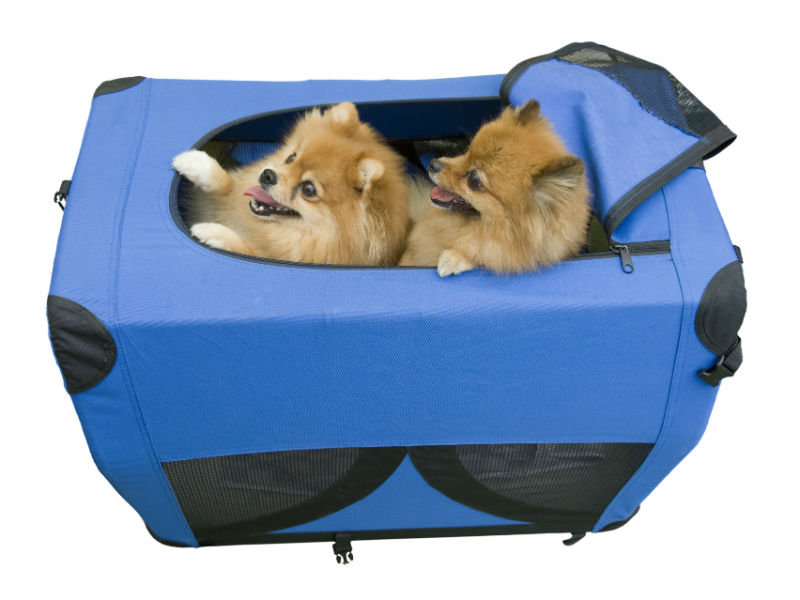AKC is a participant in affiliate advertising programs designed to provide a means for sites to earn advertising fees by advertising and linking to akc.org. If you purchase a product through this article, we may receive a portion of the sale.
Whether you and your dog travel the world together or you just need something to carry your dog to the vet, a dog carrier is a useful tool. A dog carrier or travel crate keeps your dog safe while riding in a vehicle, and makes it possible for you to take dogs on planes. There are so many types of dog carriers on the market that you have more options to choose from now than just heavy, hard-sided crates, depending on what you’re using it for. But before you choose a dog carrier, here are some helpful guidelines to narrow down your picks.
Measure Your Dog
You’ll need to know your dog’s height and length in order to choose the right carrier size. The carrier should be large enough for your dog to turn around easily and to curl up or stretch out when lying down. Measure your dog’s back from his neck, where the collar sits, to the base of their tail. Then add a few inches to that measurement.
Measure your dog’s shoulder height from the top of their shoulders to the ground. For soft-sided carriers, add two-to-three inches to shoulder height. For hard-sided carriers, add three-to-five inches. Wearable carriers, like backpacks and slings, are meant to be snug and cozy; the dog’s weight is supported by your body as well as by the carrier itself. For all kinds of carriers, your dog’s weight is another factor to consider. Manufacturers list size and weight limits for carriers, and if your dog is between sizes or weights, choose the larger size.

What Are You Using the Dog Carrier For?
If a dog carrier is to keep your dog contained when they go out with you on short trips, you might want to pick something lightweight, easy to carry, easy to pack, and comfortable for your dog. For longer or frequent car rides, you might opt for a more heavy-duty crate designed for the purpose.
If you plan to fly, airlines have stringent regulations for pet carriers, and you should always check the latest airline or FAA regulations. There are size and construction requirements, and you don’t want to get to the gate only to discover that the airline won’t allow the carrier you chose for your dog.
Choosing a Dog Carrier Style
Dog carriers come in several basic styles, and you’ll want to select the type that suits your dog and your activities.
Hard-sided dog carriers are sometimes preferred for their durability and rugged construction. The hard shell dog crate or carrier offers a bit more protection for your dog and is easy to clean. If you’re traveling by air and your dog is too large to travel under the seat in front of you, some hard-shell carriers are approved by the airlines to travel in cargo. (All of your dog’s travel arrangements should be sorted with your airline well in advance of your trip.) You may prefer a top-loading carrier that allows you to lift your dog and place him inside.
Soft-sided dog carriers are the most popular style for transporting smaller dogs, and some styles of soft-sided dog carriers are approved by airlines to go under your seat. These are typically designed to be light and portable, and they fold up for easy storage. Check the size and weight specifications from the manufacturer; many owners say they need to go a size larger.
Wearable dog carriers have become increasingly popular. They keep your hands free and make it easy to take your dog almost anywhere that pet dogs are allowed. Of course, they’re only really practical for small dogs or puppies, and certain activities. Shoulder-sling dog carriers allow your dog to nestle inside or keep his head free to watch the world go by. They’re washable, lightweight, and some come with zippers for added security.
Front packs or backpacks are another wearable option. Some styles of backpack dog carriers can be used either as a front pack or backpack, with adjustable straps and holes for your dog’s legs.
Rolling dog carriers help when even a small dog starts feeling heavy after a while. Rolling dog carriers with wheels have the advantage of being easy on you while they also keep your dog from being jostled around. Although not recommended for use during rugged hiking, they’re a good option for city walking and in airports. If you plan to use a rolling carrier for plane travel, make sure to check the airline’s requirements first.
Dog carriers aren’t just for the tiniest of toy Poodles or short-legged Dachshunds. Whether you need to take your dog on an airplane or have dog with mobility challenges who still enjoys taking walks with you, the right dog carrier is an easy, convenient way to take your dog along.



